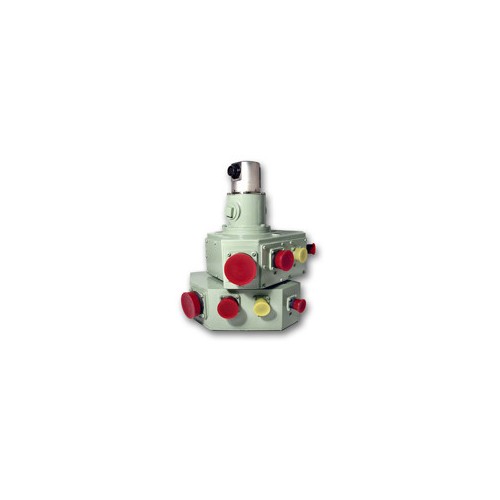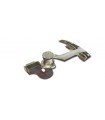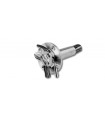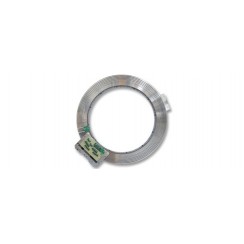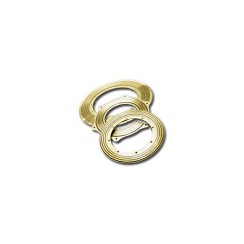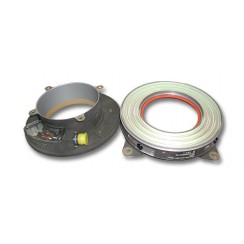The increasing complexity of modern military vehicles demands slip rings that provide reliable electrical interfaces between the stationary and rotating parts of these vehicles. Moog slip rings have been chosen to operate on numerous vehicular programs to meet these challenges. M1 / A2 and M60 tanks, A2 / A3 Bradley Fighting Vehicles, Stryker, Light Armored Vehicles (LAVs), and V150 Commando Vehicles are just a small sample of these vehicular programs.
Technological developments have yielded stabilized gun systems, laser target acquisition and fire control systems, and high bandwidth data communications that create unique demands for vehicular slip rings. We meet all of these challenges effectively and economically.
For more information about how Moog's vehicular slip rings can fit your specific application, contact our slip ring experts.
Features
- Supports modern data communication technologies
- Full environmental sealing capabilities
- EMI shielding available
- Range of operating voltages compatible with any vehicular system
- Hydraulic rotary joint options
- Gold-on-gold contacts for signal and data integrity
- Meets military shock and vibration requirements
- Speed, torque and frequency characteristics designed for specific vehicular applications
- High power capability to support present and future vehicular system needs
- High frequency coax channels available
- Through-bore designs
- Cam-operated microswitches
- Vertical integration with resolvers, fiber optics, fluidic interfaces, hydraulics, pneumatics and motors
- Filtered air transfer for chemical, biological and radiological (NBC) requirements and / or electronics cooling and pneumatic rotary joint options for crew station breathing and electronic cooling
- High speed data capabilities
Electrical slip rings are used in vehicles such as tanks, retrievers, light armored vehicles, mobile missile launchers, and armored personnel carriers. A typical vehicle might contain slip rings in the turret, the commander station and the infrared sight. In each of these systems, slip rings have provided reliable signal and power coupling under the most rugged battlefield conditions.
In addition to producing compact slip rings where minimal space is available, we have provided units that combine conventional electrical slip rings with resolvers, encoders, fiber optics, pneumatics and hydraulics rotary joints.
Design
Moog can offer the most valuable design assistance by being involved early in the development of the vehicle. The internal design of the slip ring capsule will be driven by the circuit requirements and the space available for mounting the slip ring capsule. From our vast product line, we can pull from the following design criteria:
- Use of existing designs
- Single drum
- Concentric drums
- Single pancake
- Stacked pancakes
- Combination of designs
- Clear through-bore to allow another device to occupy the centerline
- Connectors – case mounted or attached to cables
- Mechanical support – on either side of the rotating interface
Power Circuits
Theoretically, there is no limit to the amount of power that can be transferred by the slip ring capsule. Most hull-to-turret slip ring capsules are capable of transferring 150 amps continuously. It is important that the power duty cycles (including surge currents) be accurately defined as early as possible in the design stage. (Requiring the slip ring capsule to operate at continuous current levels that will not be encountered in the field takes space that could be more effectively used for signal requirements.) If the space available for the slip ring capsule is limited, it may be advantageous to transfer the power at higher voltages (e.g. 208 VAC) and lower currents. The power ground can be made through the case of the slip ring capsule or insulated from case ground.
Signal Circuits
Signal requirements for vehicular slip ring capsules continue to be increasingly demanding. The circuit functions and electrical isolation requirements have a significant impact on the design of the slip ring capsule. A typical vehicular slip ring will include circuits for powering electronic equipment, video circuits, and analog and digital control circuits.
Sometimes it is important that sensitive circuits have additional isolation from other circuits to meet heightened sensitivity requirements. Circuit isolation requirements are more easily addressed early in the design stages.
Slip Ring Expertise
Vehicles such as tanks, retrievers, mobile missile launchers, light armored vehicles and armored personnel carriers pose a variety of challenges. Hydraulically-actuated equipment in the turret may require the combination of conventional electrical slip ring with a hydraulic joint to form an electrohydraulic slip ring, thereby providing reliable fluidic interfacing. The threat of a NBC environment may require pneumatic channels through the slip ring to provide filtered air to crew members’ facemasks. The introduction of an independently rotating commander station or cupola may require a slip ring large enough in diameter to encompass the station, yet very thin in cross section to minimize space requirements. These advances in military technology, plus many others, have challenged the capabilities of the slip ring industry, demanding equally sophisticated solutions for reliable vehicle operation.
Moog consistently meets these challenges successfully and economically. For more than 50 years we have been involved in the design, development, and production of quality slip rings for many diverse applications. Recognized as leaders in slip ring research and testing, our team of engineers, scientists, and manufacturing personnel have focused their total resources toward one goal—providing you with the best possible product.

